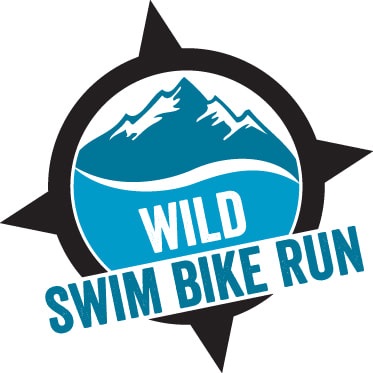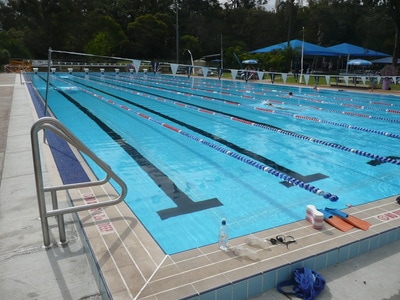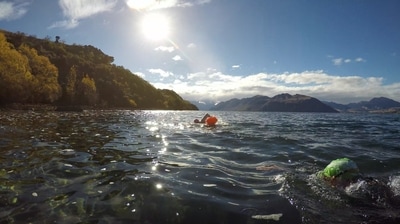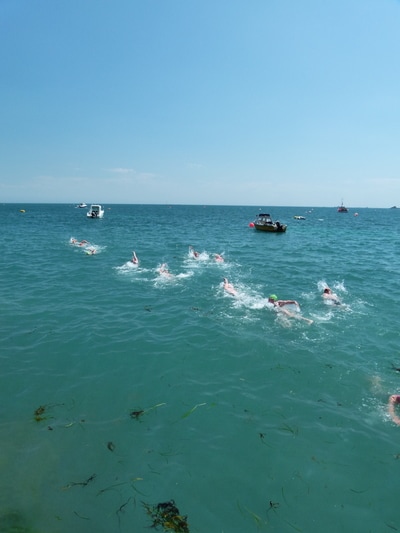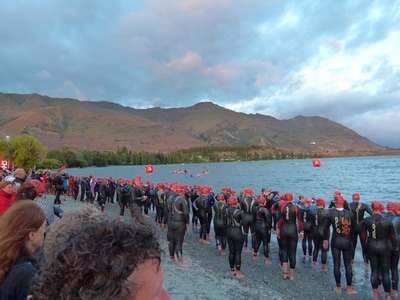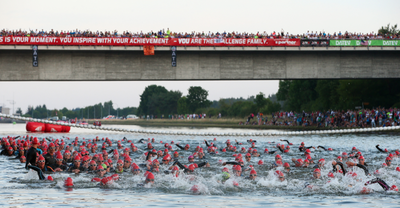Wild swimming, open water, triathlon and pool swimming...
Of all the sports swimming can be the most accessible, rewarding and physically beneficial. If you don't come from a swimming background it can also be the most intimidating, exhausting and frustrating as technique is the key to an economic, efficient stroke. If you were lucky enough to be taught to swim at a young age you will likely have confidence in the water, however, technique taught early fades over time which can lead to frustration when you feel you should be swimming faster at races and on groups swims. If you are starting as a novice or beginner joining a local swim club or pool will provide access to classes and coaching from which you will be able to develop correct technique from which speed, strength and endurance can be developed.
Following Darroch's first ironman distance triathlons where finishing had been the focus he became frustrated that regardless of how far he swam in training that he wasn't getting any quicker. Being lucky enough to have friends who were strong pool, open water and triathlon swimmers he was able to to identify with them that his swim training lacked the structure required to improve technique, speed and endurance. Combining their input with training advice and information available online from some of the worlds top triathletes/swimmers, Darroch was able to develop a progressive swimming programme to fit a busy job with frequent overseas travel. Some valuable lessons Darroch took away from this were that; good technique is the strongest foundation from which improvements can be made; balance pool and open water swims in your programme; if possible organise or join some group swims and mix up sessions to keep you hooked!
We have broken swimming into 3 categories; pool, open water and triathlon swimming identifying key information that support the development of technique, fitness and safety in the water.
Pool
Most people aren't lucky enough to have open water on their doorstep resorting to pool swimmming for fitness and the development of technique. For some, pool swimming can be boring so adding structure to sessions will increase enjoyment, gains and confidence.
Following Darroch's first ironman distance triathlons where finishing had been the focus he became frustrated that regardless of how far he swam in training that he wasn't getting any quicker. Being lucky enough to have friends who were strong pool, open water and triathlon swimmers he was able to to identify with them that his swim training lacked the structure required to improve technique, speed and endurance. Combining their input with training advice and information available online from some of the worlds top triathletes/swimmers, Darroch was able to develop a progressive swimming programme to fit a busy job with frequent overseas travel. Some valuable lessons Darroch took away from this were that; good technique is the strongest foundation from which improvements can be made; balance pool and open water swims in your programme; if possible organise or join some group swims and mix up sessions to keep you hooked!
We have broken swimming into 3 categories; pool, open water and triathlon swimming identifying key information that support the development of technique, fitness and safety in the water.
Pool
Most people aren't lucky enough to have open water on their doorstep resorting to pool swimmming for fitness and the development of technique. For some, pool swimming can be boring so adding structure to sessions will increase enjoyment, gains and confidence.
- Equipment - There are lots of swim training aides available. Pull buoys, kick boards and hand paddles will cater for most of your training requirements and are relatively inexpensive.
- Structure - There are days when you just want to go to the pool and have a swim without a programme. For the other days, get some structure to your training, set goals, gauge improvment and always warm up/down. Typically we break down a session into 10 minute warm up, 40 minutes training and a 10 minute warm down.
- Clubs and Coaching - If you struggle with motivation or aren't confident developing your own technique and development, clubs and local coaches are a great place to start.
Open Water
For us this is the most enjoyable and rewarding, it can also be the most challenging, capable of pulling you out of your comfort zone very quickly. There are some amazing wild or open water swimming spots in the UK, many of these are on your doorstep and include lakes, ponds, lochs, tarns, rivers, estuaries and the sea! Whilst there is a group of swimmers (known as non-wet swimmers!) who seem unaffected by cold water, we prefer wetsuits to increase your enjoyment and ability to stay in the water for longer. A vital factor supporting your enjoyment of wild swimming is 'safety', the UK's waters are as dangerous as any in the world with too many people losing their lives every year.
For us this is the most enjoyable and rewarding, it can also be the most challenging, capable of pulling you out of your comfort zone very quickly. There are some amazing wild or open water swimming spots in the UK, many of these are on your doorstep and include lakes, ponds, lochs, tarns, rivers, estuaries and the sea! Whilst there is a group of swimmers (known as non-wet swimmers!) who seem unaffected by cold water, we prefer wetsuits to increase your enjoyment and ability to stay in the water for longer. A vital factor supporting your enjoyment of wild swimming is 'safety', the UK's waters are as dangerous as any in the world with too many people losing their lives every year.
- Type of Water – The difference between swimming in the sea, a river or a lake is significant. No two bodies of water are the same and will present different challenges and risks. It is important that you do your research before you jump into the water and always seek out local knowledge its invaluable!
- Water Temperature – Not only will it determine your level of enjoyment but it will also affect how long you can stay in it and if the weather changes on you, it's safety. You should take this into account before you plan a big swim, especially if you are part of or leading a group.
- Weather – The effect weather has on a body of water can be dramatic, a flat lake can blow up very quickly potentially forcing you to beach kilometers away from your planned exit point or worse onto difficult and dangerous terrain.
- Technique - Once you have a confident stroke and feel happy in open water the next challenge will be swimming in a straight line and relaxed breathing in choppy water. Sighting is a key element to your swim plan, prior to getting in the water you should have looked for reference points you can use in the water to maintain the line you want to swim. The ability to bilateral breathe (breathe on both sides) is hugely beneficial as waves will tend to break on one side of your body, forcing you to breathe on the sheltered side of your body. Depending on where you are swimming waves can be unpredictable so you have to practise getting a feel for the water behaviour, gauging the rise and fall of your body in the water and the water level on your face. If you can master all of the above you will find that swimming in more challenging water conditions can be great fun and enhance your confidence and comfort in the water.
Triathlon
The build up to your first triathlon can be intimidating and nerve wracking, the fact the swim is the first step on that journey can really notch up anxiety levels. Thankfully you can prepare for this in your training, research, organisation and by conducting a walk through of this stage of your race. Visualisation is a great tool to ensure that you have rehearsed equipment preparation, entry, start, race position, sighting, pacing, response to problems, exit and transition - lots to think about!
The build up to your first triathlon can be intimidating and nerve wracking, the fact the swim is the first step on that journey can really notch up anxiety levels. Thankfully you can prepare for this in your training, research, organisation and by conducting a walk through of this stage of your race. Visualisation is a great tool to ensure that you have rehearsed equipment preparation, entry, start, race position, sighting, pacing, response to problems, exit and transition - lots to think about!
- Kit Considerations - Once you have purchased your kit test it, get to know it and understand any issues it has. Kit will deteriorate over time, more quickly if poorly maintained and will always fail when your are least prepared!
- Comfort - Wetsuits can chafe skin quickly and painfully, lubricants are available to alleviate this issue. Goggles can leak and mist up so ensure you race with a pair that won't let you down, some people keep race goggles for that reason.
- Race Position - Working our where you want to be at the start and during a race be challenging. If you want quieter water then placing yourself further down the field or wider out. If you plan on a competitive swim you will need to jostle for position and be prepared to hold it as there are no rules in the water, especially when you are in a mass of flailing arms and legs. Dependent on the shape of the course there will be some quieter areas of water, the line inside the swimming buoys can be quieter and provide a direct line during the swim.
- Sighting - Sighting is something that requires practise, it should be come a part of your stroke ensuring minimal disruption to your cadence and breathing. Part of your preparation for the swim should be to study prominent reference points that you can use in the water to swim straighter and also gauge where you are in the race. Whilst swimming you should check these regularly to ensure you're swimming the most efficient line.
- Drafting - There are no rules concerning drafting during a swim! If you can master the art you will save energy and swim faster if you can hold onto the feet of a faster swimmer. It can be difficult to hold the same swimmer for a long period so you may find yourself picking up a couple of swimmers throughout the race. You don't get this kind of assistance anywhere else in the race so make the most of it!
- Pacing - The start of the swim can be an emotional spot, everybody is feeding off nervous energy, music is often pumping and when the gun fires the water is threshed as the field explodes into action. It is important to stick to your race plan, as you can easily waste energy by getting carried away and blasting the first few hundred metres. Stay calm and stick to your plan, this is the foundation of your race so build it well.
